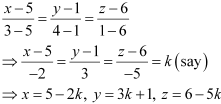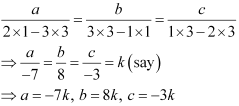
NCERT Solutions for Class 12 Maths Chapter 11 Miscellaneous Exercise (Three-Dimensional Geometry)
NCERT Solutions for Class 12 Maths Chapter 11 Miscellaneous Exercise of Three Dimensional Geometry is prepared by the academic team of Physics Wallah. We have prepared NCERT Solutions for all exercise of chapter 11. Given below are step-by-step solutions to all questions given in the NCERT Solutions for Class 12 Maths Chapter 11 Miscellaneous Exercise of Three-Dimensional Geometry.NCERT Solutions for Class 12 Maths Chapter 11 Exercise 11.1
NCERT Solutions for Class 12 Maths Chapter 11 Miscellaneous Exercise Overview
NCERT Solutions for Class 12 Maths Chapter 11 Miscellaneous Excercise addresses these significant subjects. In order to fully comprehend the concepts presented in the chapter and make effective use of the provided solutions, it is recommended that students go over each topic in great detail. The intention is for students to effortlessly achieve excellent exam scores after reviewing and practicing these responses.NCERT Solutions for Class 12 Maths Chapter 11 Miscellaneous Exercise
Solve The Following Questions of NCERT Solutions for Class 12 Maths Chapter 11 Miscellaneous Exercise:
Question 1.Show that the line joining the origin to the point (2, 1, 1) is perpendicular to the line determined by the points (3, 5, −1), (4, 3, −1). Solution : Let OA be the line joining the origin, O (0, 0, 0), and the point, A (2, 1, 1). Also, let BC be the line joining the points, B (3, 5, −1) and C (4, 3, −1). The direction ratios of OA are 2, 1, and 1 and of BC are (4 − 3) = 1, (3 − 5) = −2, and (−1 + 1) = 0 OA is perpendicular to BC, if a 1 a 2 + b 1 b 2 + c 1 c 2 = 0 ∴ a 1 a 2 + b 1 b 2 + c 1 c 2 = 2 × 1 + 1 (−2) + 1 ×0 = 2 − 2 = 0 Thus, OA is perpendicular to BC.NCERT Solutions for Class 12 Maths Chapter 11 Exercise 11.2
Question 2. If l 1 , m 1 , n 1 and l 2 , m 2 , n 2 are the direction cosines of two mutually perpendicular lines, show that the direction cosines of the line perpendicular to both of these are m 1 n 2 − m 2 n 1 , n 1 l 2 − n 2 l 1 , l 1 m 2 − l 2 m 1 . Solution : It is given that l 1 , m 1 , n 1 and l 2 , m 2 , n 2 are the direction cosines of two mutually perpendicular lines. Therefore, Let
l
,
m
,
n
be the direction cosines of the line which is perpendicular to the line with direction cosines
l
1
,
m
1
,
n
1
and
l
2
,
m
2
,
n
2
.
Let
l
,
m
,
n
be the direction cosines of the line which is perpendicular to the line with direction cosines
l
1
,
m
1
,
n
1
and
l
2
,
m
2
,
n
2
.
 l
,
m
,
n
are the direction cosines of the line.
∴
l
2
+
m
2
+
n
2
= 1 … (5)
It is known that,
l
,
m
,
n
are the direction cosines of the line.
∴
l
2
+
m
2
+
n
2
= 1 … (5)
It is known that,
 Substituting the values from equations (5) and (6) in equation (4), we obtain
Substituting the values from equations (5) and (6) in equation (4), we obtain
 Thus, the direction cosines of the required line are
Thus, the direction cosines of the required line are

NCERT Solutions for Class 12 Maths Chapter 11 Exercise 11.3
Question 3.Find the angle between the lines whose direction ratios are a , b , c and b − c , c − a , a − b . Solution : The angle Q between the lines with direction cosines, a , b , c and b − c , c − a , a − b , is given by, Thus, the angle between the lines is 90°
Question 4.Find the equation of the line parallel to x-axis and passing through the origin.
Solution :
The line parallel to
x
-axis and passing through the origin is
x
-axis itself.
Let A be a point on
x
-axis. Therefore, the coordinates of A are given by (
a
, 0, 0), where
a
∈ R.
Direction ratios of OA are (
a
− 0) =
a
, 0, 0
The equation of OA is given by,
Thus, the angle between the lines is 90°
Question 4.Find the equation of the line parallel to x-axis and passing through the origin.
Solution :
The line parallel to
x
-axis and passing through the origin is
x
-axis itself.
Let A be a point on
x
-axis. Therefore, the coordinates of A are given by (
a
, 0, 0), where
a
∈ R.
Direction ratios of OA are (
a
− 0) =
a
, 0, 0
The equation of OA is given by,
 Thus, the equation of line parallel to
x
-axis and passing through origin is
x/1 = y/0 = z/0
Question
5.If the coordinates of the points A, B, C, D be (1, 2, 3), (4, 5, 7), (−4, 3, −6) and (2, 9, 2) respectively, then find the angle between the lines AB and CD.
Solution :
The coordinates of A, B, C, and D are (1, 2, 3), (4, 5, 7), (−4, 3, −6), and
(2, 9, 2) respectively.
The direction ratios of AB are (4 − 1) = 3, (5 − 2) = 3, and (7 − 3) = 4
The direction ratios of CD are (2 −(− 4)) = 6, (9 − 3) = 6, and (2 −(−6)) = 8
It can be seen that, a1/a2 = b1/b2 = c1/c2 = 1/2
Therefore, AB is parallel to CD.
Thus, the angle between AB and CD is either 0° or 180°.
Question
6.If the lines
Thus, the equation of line parallel to
x
-axis and passing through origin is
x/1 = y/0 = z/0
Question
5.If the coordinates of the points A, B, C, D be (1, 2, 3), (4, 5, 7), (−4, 3, −6) and (2, 9, 2) respectively, then find the angle between the lines AB and CD.
Solution :
The coordinates of A, B, C, and D are (1, 2, 3), (4, 5, 7), (−4, 3, −6), and
(2, 9, 2) respectively.
The direction ratios of AB are (4 − 1) = 3, (5 − 2) = 3, and (7 − 3) = 4
The direction ratios of CD are (2 −(− 4)) = 6, (9 − 3) = 6, and (2 −(−6)) = 8
It can be seen that, a1/a2 = b1/b2 = c1/c2 = 1/2
Therefore, AB is parallel to CD.
Thus, the angle between AB and CD is either 0° or 180°.
Question
6.If the lines
 are perpendicular, find the value of k
Solution :
The direction of ratios of the lines,
are perpendicular, find the value of k
Solution :
The direction of ratios of the lines,
 , are −3, 2
k
, 2 and 3
k
, 1, −5 respectively.
It is known that two lines with direction ratios,
a
1
,
b
1
,
c
1
and
a
2
,
b
2
, c
2
, are perpendicular, if
a
1
a
2
+
b
1
b
2
+
c
1
c
2
= 0
, are −3, 2
k
, 2 and 3
k
, 1, −5 respectively.
It is known that two lines with direction ratios,
a
1
,
b
1
,
c
1
and
a
2
,
b
2
, c
2
, are perpendicular, if
a
1
a
2
+
b
1
b
2
+
c
1
c
2
= 0
 Therefore, for k= -10/7, the given lines are perpendicular to each other.
Question
7.Find the vector equation of the line passing through (1, 2, 3) and perpendicular to the plane
Therefore, for k= -10/7, the given lines are perpendicular to each other.
Question
7.Find the vector equation of the line passing through (1, 2, 3) and perpendicular to the plane
 Solution :
The position vector of the point (1, 2, 3) is
Solution :
The position vector of the point (1, 2, 3) is
 The direction ratios of the normal to the plane,
The direction ratios of the normal to the plane,
 , are 1, 2, and −5 and the normal vector is
, are 1, 2, and −5 and the normal vector is
 The equation of a line passing through a point and perpendicular to the given plane is given by,
The equation of a line passing through a point and perpendicular to the given plane is given by,
 Question
8.Find the equation of the plane passing through (
a
,
b
,
c
) and parallel to the plane
Question
8.Find the equation of the plane passing through (
a
,
b
,
c
) and parallel to the plane
 Solution :
Any plane parallel to the plane,
Solution :
Any plane parallel to the plane,
 , is of the form
, is of the form
 .......(1)
The plane passes through the point (
a
,
b
,
c
). Therefore, the position vector
.......(1)
The plane passes through the point (
a
,
b
,
c
). Therefore, the position vector
.png) of this point is
of this point is
 Therefore, equation (1) becomes
Therefore, equation (1) becomes
 Substituting
Substituting
 in equation (1), we obtain
in equation (1), we obtain
 This is the vector equation of the required plane.
Substituting
This is the vector equation of the required plane.
Substituting
 in equation (2), we obtain
in equation (2), we obtain
 Question
9.Find the shortest distance between lines
Question
9.Find the shortest distance between lines
 Solution :
The given lines are
Solution :
The given lines are
 It is known that the shortest distance between two lines,
It is known that the shortest distance between two lines,
 is given by
is given by
.png) Comparing
Comparing
 to equations (1) and (2), we obtain
to equations (1) and (2), we obtain
 Substituting all the values in equation (1), we obtain
Substituting all the values in equation (1), we obtain
 Therefore, the shortest distance between the two given lines is 9 units.
Question
10.Find the coordinates of the point where the line through (5, 1, 6) and (3, 4, 1) crosses the YZ-plane.
Solution :
It is known that the equation of the line passing through the points, (
x
1
,
y
1
,
z
1
) and (
x
2
,
y
2
,
z
2
), is
Therefore, the shortest distance between the two given lines is 9 units.
Question
10.Find the coordinates of the point where the line through (5, 1, 6) and (3, 4, 1) crosses the YZ-plane.
Solution :
It is known that the equation of the line passing through the points, (
x
1
,
y
1
,
z
1
) and (
x
2
,
y
2
,
z
2
), is
 The line passing through the points, (5, 1, 6) and (3, 4, 1), is given by,
The line passing through the points, (5, 1, 6) and (3, 4, 1), is given by,
 Any point on the line is of the form (5 − 2
k
, 3
k
+ 1, 6 −5
k
).
The equation of YZ-plane is
x
= 0
Since the line passes through YZ-plane,
5 − 2
k
= 0
Any point on the line is of the form (5 − 2
k
, 3
k
+ 1, 6 −5
k
).
The equation of YZ-plane is
x
= 0
Since the line passes through YZ-plane,
5 − 2
k
= 0
 Therefore, the required point is
Therefore, the required point is
 .
.
Question 11.Find the coordinates of the point where the line through (5, 1, 6) and (3, 4, 1) crosses the ZX-plane.
Solution : It is known that the equation of the line passing through the points, ( x 1 , y 1 , z 1 ) and ( x 2 , y 2 , z 2 ), is.png) The line passing through the points, (5, 1, 6) and (3, 4, 1), is given by,
The line passing through the points, (5, 1, 6) and (3, 4, 1), is given by,
 Any point on the line is of the form (5 − 2
k
, 3
k
+ 1, 6 −5
k
).
Since the line passes through ZX-plane,
Any point on the line is of the form (5 − 2
k
, 3
k
+ 1, 6 −5
k
).
Since the line passes through ZX-plane,
 Question
12
. Find the coordinates of the point where the line through (3, −4, −5) and (2, − 3, 1) crosses the plane 2
x
+
y
+
z
= 7).
Solution :
It is known that the equation of the line through the points, (
x
1
,
y
1
,
z
1
) and (
x
2
,
y
2
,
z
2
), is
Question
12
. Find the coordinates of the point where the line through (3, −4, −5) and (2, − 3, 1) crosses the plane 2
x
+
y
+
z
= 7).
Solution :
It is known that the equation of the line through the points, (
x
1
,
y
1
,
z
1
) and (
x
2
,
y
2
,
z
2
), is
.png) Since the line passes through the points, (3, −4, −5) and (2, −3, 1), its equation is given by,
Since the line passes through the points, (3, −4, −5) and (2, −3, 1), its equation is given by,
 Therefore, any point on the line is of the form (3 −
k
,
k
− 4, 6
k
− 5).
This point lies on the plane, 2
x
+
y
+
z
= 7
∴ 2 (3 −
k
) + (
k
− 4) + (6
k
− 5) = 7
5k - 3 = 7
k = 2
Hence, the coordinates of the required point are (3 − 2, 2 − 4, 6 × 2 − 5) i.e.,
(1, −2, 7).
Question
13.
Find the equation of the plane passing through the point (−1, 3, 2) and perpendicular to each of the planes
x
+ 2
y
+ 3
z
= 5 and 3
x
+ 3
y
+
z
= 0.
Solution :
The equation of the plane passing through the point (−1, 3, 2) is
a
(
x
+ 1) +
b
(
y
− 3) +
c
(
z
− 2) = 0 … (1)
where,
a
,
b
,
c
are the direction ratios of normal to the plane.
It is known that two planes,
Therefore, any point on the line is of the form (3 −
k
,
k
− 4, 6
k
− 5).
This point lies on the plane, 2
x
+
y
+
z
= 7
∴ 2 (3 −
k
) + (
k
− 4) + (6
k
− 5) = 7
5k - 3 = 7
k = 2
Hence, the coordinates of the required point are (3 − 2, 2 − 4, 6 × 2 − 5) i.e.,
(1, −2, 7).
Question
13.
Find the equation of the plane passing through the point (−1, 3, 2) and perpendicular to each of the planes
x
+ 2
y
+ 3
z
= 5 and 3
x
+ 3
y
+
z
= 0.
Solution :
The equation of the plane passing through the point (−1, 3, 2) is
a
(
x
+ 1) +
b
(
y
− 3) +
c
(
z
− 2) = 0 … (1)
where,
a
,
b
,
c
are the direction ratios of normal to the plane.
It is known that two planes,
 Plane (1) is perpendicular to the plane,
x
+ 2
y
+ 3
z
= 5
a.1 + b .2 + c.3 = 0
a + 2b + 3c = 0 ....(2)
Also, plane (1) is perpendicular to the plane, 3
x
+ 3
y
+
z
= 0
a .3 + b.3 + c.1 = 0
3a + 3b + c = 0 .....(3)
From equations (2) and (3), we obtain
Plane (1) is perpendicular to the plane,
x
+ 2
y
+ 3
z
= 5
a.1 + b .2 + c.3 = 0
a + 2b + 3c = 0 ....(2)
Also, plane (1) is perpendicular to the plane, 3
x
+ 3
y
+
z
= 0
a .3 + b.3 + c.1 = 0
3a + 3b + c = 0 .....(3)
From equations (2) and (3), we obtain
 Substituting the values of
a
,
b
, and
c
in equation (1), we obtain
Substituting the values of
a
,
b
, and
c
in equation (1), we obtain
 This is the required equation of the plane.
Question
14. If the points (1, 1,
p
) and (−3, 0, 1) be equidistant from the plane
This is the required equation of the plane.
Question
14. If the points (1, 1,
p
) and (−3, 0, 1) be equidistant from the plane
 then find the value of p
Solution :
The position vector through the point (1, 1,
p
) is
then find the value of p
Solution :
The position vector through the point (1, 1,
p
) is
 Similarly, the position vector through the point (−3, 0, 1) is
Similarly, the position vector through the point (−3, 0, 1) is
 The equation of the given plane is
The equation of the given plane is
 It is known that the perpendicular distance between a point whose position vector is
It is known that the perpendicular distance between a point whose position vector is
.png) and the plane,
and the plane,
 is given by,
is given by,
 Here,
Here,
 and
d
= -13
Therefore, the distance between the point (1, 1,
p
) and the given plane is
and
d
= -13
Therefore, the distance between the point (1, 1,
p
) and the given plane is
 Similarly, the distance between the point (−3, 0, 1) and the given plane is
Similarly, the distance between the point (−3, 0, 1) and the given plane is
 It is given that the distance between the required plane and the points, (1, 1,
p
) and (−3, 0, 1), is equal.
∴
D
1
=
D
2
It is given that the distance between the required plane and the points, (1, 1,
p
) and (−3, 0, 1), is equal.
∴
D
1
=
D
2
 Question
15.Find the equation of the plane passing through the line of intersection of the planes
Question
15.Find the equation of the plane passing through the line of intersection of the planes
 and
and
 and parallel to x - axis.
Solution :
Equation of one plane is
and parallel to x - axis.
Solution :
Equation of one plane is

 The equation of any plane passing through the line of intersection of these planes is
The equation of any plane passing through the line of intersection of these planes is
 Its direction ratios are (2λ + 1), (3λ + 1), and (1 − λ).
The required plane is parallel to
x
-axis. Therefore, its normal is perpendicular to
x
-axis.
The direction ratios of
x
-axis are 1, 0, and 0.
Its direction ratios are (2λ + 1), (3λ + 1), and (1 − λ).
The required plane is parallel to
x
-axis. Therefore, its normal is perpendicular to
x
-axis.
The direction ratios of
x
-axis are 1, 0, and 0.
 Substituting λ = -1/2 in equation (1), we obtain
Substituting λ = -1/2 in equation (1), we obtain
 Therefore, its Cartesian equation is
y
− 3
z
+ 6 = 0
This is the equation of the required plane.
Therefore, its Cartesian equation is
y
− 3
z
+ 6 = 0
This is the equation of the required plane.
Question16. If O be the origin and the coordinates of P be (1, 2, −3), then find the equation of the plane passing through P and perpendicular to OP.
Solution : The coordinates of the points, O and P, are (0, 0, 0) and (1, 2, −3) respectively. Therefore, the direction ratios of OP are (1 − 0) = 1, (2 − 0) = 2, and (−3 − 0) = −3 It is known that the equation of the plane passing through the point ( x 1 , y 1 z 1 ) is a(x - x 1 ) + b(y - y 1 ) + c(z - z 1 ) = 0where, a, b , and c are the direction ratios of normal. Here, the direction ratios of normal are 1, 2, and −3 and the point P is (1, 2, −3). Thus, the equation of the required plane is 1(x - 1) + 2(y - 2) - 3(z + 3) 0 ⇒ x + 2y - 3z - 14 = 0 Question 17.Find the equation of the plane which contains the line of intersection of the planes and which is perpendicular to the plane
and which is perpendicular to the plane
 Solution :
The equations of the given planes are
Solution :
The equations of the given planes are
 The equation of the plane passing through the line intersection of the plane given in equation (1) and equation (2) is
The equation of the plane passing through the line intersection of the plane given in equation (1) and equation (2) is
 The plane in equation (3) is perpendicular to the plane,
The plane in equation (3) is perpendicular to the plane,

 Substituting λ = 7/19 in equation (3), we obtain
Substituting λ = 7/19 in equation (3), we obtain
 This is the vector equation of the required plane.
The Cartesian equation of this plane can be obtained by substituting
This is the vector equation of the required plane.
The Cartesian equation of this plane can be obtained by substituting
 in equation (3).
in equation (3).
 Question
18.Find the distance of the point (−1, −5, −10) from the point of intersection of the line
Question
18.Find the distance of the point (−1, −5, −10) from the point of intersection of the line
 and the plane
and the plane
 Solution :
The equation of the given line is
Solution :
The equation of the given line is
 .....(1)
The equation of the given plane is
.....(1)
The equation of the given plane is
 .......(2)
Substituting the value of
.......(2)
Substituting the value of
.png) from equation (1) in equation (2), we obtain
from equation (1) in equation (2), we obtain
 Substituting this value in equation (1), we obtain the equation of the line as
Substituting this value in equation (1), we obtain the equation of the line as
 This means that the position vector of the point of intersection of the line and the plane is
This means that the position vector of the point of intersection of the line and the plane is
 This shows that the point of intersection of the given line and plane is given by the coordinates, (2, −1, 2). The point is (−1, −5, −10).
The distance
d
between the points, (2, −1, 2) and (−1, −5, −10), is
This shows that the point of intersection of the given line and plane is given by the coordinates, (2, −1, 2). The point is (−1, −5, −10).
The distance
d
between the points, (2, −1, 2) and (−1, −5, −10), is
 Question
19.Find the vector equation of the line passing through (1, 2, 3) and parallel to the plane
Question
19.Find the vector equation of the line passing through (1, 2, 3) and parallel to the plane
 and
and
 Solution :
Let the required line be parallel to vector
Solution :
Let the required line be parallel to vector
.png) given by,
given by,
 The position vector of the point (1, 2, 3) is
The position vector of the point (1, 2, 3) is
 The equation of line passing through (1, 2, 3) and parallel to
The equation of line passing through (1, 2, 3) and parallel to
.png) is given by,
is given by,
 The equations of the given planes are
The equations of the given planes are
 .....(2)
.....(2)
 ......(3)
The line in equation (1) and plane in equation (2) are parallel. Therefore, the normal to the plane of equation (2) and the given line are perpendicular.
......(3)
The line in equation (1) and plane in equation (2) are parallel. Therefore, the normal to the plane of equation (2) and the given line are perpendicular.
 From equations (4) and (5), we obtain
From equations (4) and (5), we obtain
 Therefore, the direction ratios of
Therefore, the direction ratios of
.png) are −3, 5, and 4.
are −3, 5, and 4.
 Substituting the value of
Substituting the value of
.png) in equation (1), we obtain
in equation (1), we obtain
 This is the equation of the required line.
Question
20.Find the vector equation of the line passing through the point (1, 2, − 4) and perpendicular to the two lines:
This is the equation of the required line.
Question
20.Find the vector equation of the line passing through the point (1, 2, − 4) and perpendicular to the two lines:
 Solution :
Let the required line be parallel to the vector
Solution :
Let the required line be parallel to the vector
.png) given by,
given by,
 The position vector of the point (1, 2, − 4) is
The position vector of the point (1, 2, − 4) is
 The equation of the line passing through (1, 2, −4) and parallel to vector
The equation of the line passing through (1, 2, −4) and parallel to vector
.png) is
is
 The equations of the lines are
The equations of the lines are
 Line (1) and line (2) are perpendicular to each other.
Line (1) and line (2) are perpendicular to each other.
 Also, line (1) and line (3) are perpendicular to each other.
Also, line (1) and line (3) are perpendicular to each other.
 From equations (4) and (5), we obtain
From equations (4) and (5), we obtain
 Direction ratios of
Direction ratios of
.png) are 2, 3, and 6.
∴
are 2, 3, and 6.
∴
 Substituting
Substituting
 in equation (1), we obtain
in equation (1), we obtain
 This is the equation of the required line.
Question
21.Prove that if a plane has the intercepts a,b,c and is at a distance of P units from the origin, then
This is the equation of the required line.
Question
21.Prove that if a plane has the intercepts a,b,c and is at a distance of P units from the origin, then
 Solution :
The equation of a plane having intercepts
a
,
b
,
c
with
x
,
y
, and
z
axes respectively is given by,
Solution :
The equation of a plane having intercepts
a
,
b
,
c
with
x
,
y
, and
z
axes respectively is given by,
 The distance (
p
) of the plane from the origin is given by,
The distance (
p
) of the plane from the origin is given by,

Choose the correct answer in Exercise Q. 22 and 23.
Question 22.Distance between the two planes: 2x + 3y + 4z = 4 and 4x + 6y + 8z = 12 is (A) 2 units(B) 4 units(C) 8 units(D) 2/√29 units Solution : The equations of the planes are 2x + 3y + 4z = 4 4x + 6y + 8z = 12 ⇒ 2x + 3y + 4z = 6 It can be seen that the given planes are parallel. It is known that the distance between two parallel planes, ax + by + cz = d 1 and ax + by + cz = d 2 , is given by, Thus, the distance between the lines is 2/√29 units.
Hence, the correct answer is D.
Question
23.
The planes: 2
x
−
y
+ 4
z
= 5 and 5
x
− 2.5
y
+ 10
z
= 6 are
Thus, the distance between the lines is 2/√29 units.
Hence, the correct answer is D.
Question
23.
The planes: 2
x
−
y
+ 4
z
= 5 and 5
x
− 2.5
y
+ 10
z
= 6 are
(A) Perpendicular (B) Parallel (C) intersect y -axis
(D) passes through (0,0,5/4)
Solution : The equations of the planes are 2 x − y + 4 z = 5 … (1) 5 x − 2.5 y + 10 z = 6 … (2) It can be seen that, Therefore, the given planes are parallel.
Hence, the correct answer is B.
Therefore, the given planes are parallel.
Hence, the correct answer is B.
NCERT Solutions for Class 12 Maths Chapter 11 Miscellaneous Exercise FAQs
How many exercises are there in 3 dimensional geometry class 12?
Class 12 Maths Chapter 11 Three Dimensional Geometry has 36 questions in 3 exercises. Practicing these questions ensures an accurate and clear understanding of this topic. Students can also plan systematic learning of the various topics covered in this chapter.
Which is the easiest math chapter in class 12?
One of the easiest CBSE Class 12 Maths chapters is Algebra which consists of Matrices and Determinants. You can quickly prepare this chapter to score good marks. One of the easiest CBSE Class 12 Maths chapters is Algebra which consists of Matrices and Determinants.
Is class 12 Maths tough than 11?
No. Class 12 math is pretty easier than class 11 math in CBSE.
Which objects have 3 dimensions?
Cubes, prisms, pyramids, spheres, cones, and cylinders are all examples of three-dimensional objects.
Is class 12 Maths very tough?
Maths can be a likeable subject and students can score more in maths than any other subject once they are clear with the basics.
Talk to a counsellorHave doubts? Our support team will be happy to assist you!

Check out these Related Articles
Free Learning Resources
PW Books
Notes (Class 10-12)
PW Study Materials
Notes (Class 6-9)
Ncert Solutions
Govt Exams
Class 6th to 12th Online Courses
Govt Job Exams Courses
UPSC Coaching
Defence Exam Coaching
Gate Exam Coaching
Other Exams
Know about Physics Wallah
Physics Wallah is an Indian edtech platform that provides accessible & comprehensive learning experiences to students from Class 6th to postgraduate level. We also provide extensive NCERT solutions, sample paper, NEET, JEE Mains, BITSAT previous year papers & more such resources to students. Physics Wallah also caters to over 3.5 million registered students and over 78 lakh+ Youtube subscribers with 4.8 rating on its app.
We Stand Out because
We provide students with intensive courses with India’s qualified & experienced faculties & mentors. PW strives to make the learning experience comprehensive and accessible for students of all sections of society. We believe in empowering every single student who couldn't dream of a good career in engineering and medical field earlier.
Our Key Focus Areas
Physics Wallah's main focus is to make the learning experience as economical as possible for all students. With our affordable courses like Lakshya, Udaan and Arjuna and many others, we have been able to provide a platform for lakhs of aspirants. From providing Chemistry, Maths, Physics formula to giving e-books of eminent authors like RD Sharma, RS Aggarwal and Lakhmir Singh, PW focuses on every single student's need for preparation.
What Makes Us Different
Physics Wallah strives to develop a comprehensive pedagogical structure for students, where they get a state-of-the-art learning experience with study material and resources. Apart from catering students preparing for JEE Mains and NEET, PW also provides study material for each state board like Uttar Pradesh, Bihar, and others
Copyright © 2025 Physicswallah Limited All rights reserved.









